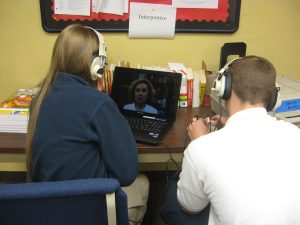We did it! Under much inspiration by @muchachitaMJ and @viajando_kj (with Megan’s presentation on stations the only general session I was able to attend at KWLA 2012), this week we did a stations day for the first time. Overall it was a great success, more so in Spanish 3 than in AP. Here’s what I learned.

First, I have really small classes, so dividing up into several stations didn’t make sense. One comment Megan made in her session got me thinking; she mentioned that because almost every station includes writing, she doesn’t want a particular one (listening, I think) to require too much writing. I thought, if every station includes writing, why not throw out the writing station. Then I thought, if we really believe that language is modal and not discrete skills, why not have stations by modes? That brought me to three stations: Interpretive, Interpersonal, and Presentational.
Note: We are not a 1:1 school but new this year (YAY!) we have 2 mobile laptop labs and I secured enough computer for my class for this activity.
Lesson from Megan: Use stations to have students construct their own preview to learning.
This was brilliant, and it was the answer to the most common complaint at the session: that designing activities for the stations takes too long.
Lesson from my experience: Don’t make tasks too complicated if you really want students to complete them.
In AP, we are in a unit on faith and the Spanish conquest in Latin America. It’s a heavy topic very relevant to my students, many of whom go on faith-based service trips. We’re using historical figures and period literature, and their final essay is about syncretism in cultural festivals in Latin America. Very heavy.
Right now we’re beginning to compare church traditions and services across cultures, evaluating why we tend to think there’s a “right” or “wrong” way to experience these things, and whether that’s valid. With that background, here are their tasks for station day:
Interpersonal: Find a blog by a church or pastor in Latin America. Read and comment on a post.
Interpretive: Locate a video of a church service in Latin America or a Hispanic church in the U.S. Note differences between the way they worship and the way you do.
Presentational: Using Audacity, talk about how your church service compares to the one you watched.
Obviously, there are obvious benefits (little planning on my part, a lot of exploration on their part) and obvious drawbacks: they couldn’t do presentational until they’d done interpretive, and the tasks are involved enough only a couple of students were able to complete them all.
Spanish 3, on the other hand, went beautifully. Tasks were just enough for students to interact with them meaningfully while still completing them.
1) Interpretive: Watch at least 2 videos on the LAITS proficiency section on describing an ailment. Then, watch a lyrics video for the song “Me duele“. Think about how to express that something is hurting you.
2) Interpersonal: Read this question on the Univisión salud forum and write your advice for the woman. (I had to choose the question rather than have them browse, due to the nature of health forums!)
3) Presentational: Draw a person and label the body parts you think you would talk about to talk about accidents or what hurts you. You can use this hospital chart as a reference. (This drawing became part of their unit vocabulary.)
This was fun, motivating, effective, and previewed the learning they would be doing all week. SUCCESS! Thanks, Megan and Kara.
1 Comments
Comments are closed.






I think I would like to do this! I think the “Rich Internet Applications” from Michigan State’s Center for Learning Education and Research could be especially helpful with this! (I’m starting to experiment with Conversations for interpersonal.)